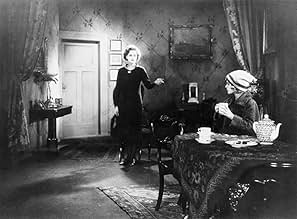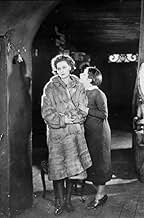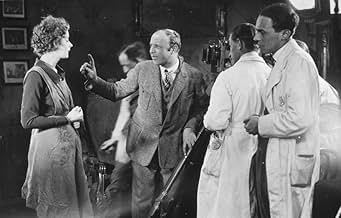VALUTAZIONE IMDb
7,0/10
1802
LA TUA VALUTAZIONE
Aggiungi una trama nella tua linguaIn post-WWI Vienna, Greta (Greta Garbo), her kid sister, and retired dad try to make it through tough times.In post-WWI Vienna, Greta (Greta Garbo), her kid sister, and retired dad try to make it through tough times.In post-WWI Vienna, Greta (Greta Garbo), her kid sister, and retired dad try to make it through tough times.
- Regia
- Sceneggiatura
- Star
Ágnes Eszterházy
- Regina Rosenow
- (as Agnes Esterhazy)
Renate Brausewetter
- Frau
- (non citato nei titoli originali)
Mario Cusmich
- Oberst Irving
- (non citato nei titoli originali)
Maria Forescu
- Frau
- (non citato nei titoli originali)
Robert Garrison
- Don Alfonso Canez
- (non citato nei titoli originali)
Valeska Gert
- Frau Greifer
- (non citato nei titoli originali)
Tamara Geva
- Lia Leid
- (non citato nei titoli originali)
Max Kohlhase
- Marias Vater
- (non citato nei titoli originali)
Recensioni in evidenza
'Joyless' is right; this brooding, silent melodrama, set in the economic shambles of post-World War I Austria, looks as if it were filmed entirely at night. Working on the same principle as a soap opera, it's an exaggerated dramatic recreation of life in hard times, when housewives were forced to sell themselves to pay for their family's next meal, while the last remnants of the aristocracy blithely danced the evenings away and worked their spurious financial schemes, ignorant of the poverty surrounding them. The complicated plot involves jealousy, murder, seduction, and Greta Garbo, looking older and wiser than any twenty year old has a right to. The film was almost a warm-up for Pabst's equally debauched 'Pandora's Box', and was also known (for good reason) as 'Street of Sorrow'.
Note: I saw what was probably the truncated version, on Super-8 (!!) The fully restored film would likely rate even higher...
Note: I saw what was probably the truncated version, on Super-8 (!!) The fully restored film would likely rate even higher...
For a long time "Die freudlose gasse" was not available in his "directors cut" form because all too explicit brothel scenes were deleted by censors. Only in 1997 a reconstruction took place. I saw the "full version". It is a good movie but above all the movie has special interest from the perspective of film history.
"Die freudlose gasse" forms a transition between the German expressionism and "die neue sachlichkeit / new objectivity". The skewed set pieces in the entrance to the nightclub of Frau Greifer reminds of German expressionism but the subject of the film is 100% new objectivity. No psychological themes such as in for example "Das Cabinet des Dr Caligari" (1920, Robert Wiene) but social engagement with the (very) poor in Vienna after the hyperinflation.
Some films emphasize the fate of the poor, for example "The grapes of wrath" (1940, John Ford). Some films emphasize the ruthlessness of the rich, for example "Wallstreet" (1987, Oliver Stone). In "Die freudlose gasse" Pabst emphasizes the contradiction between the rich and the poor. He does so by intelligent editing, and in so doing brings the theory of associative editing of Sergeij Eisenstein to the West.
There is not only a contradiction between rich and poor, but also a contradiction between poor and impoverished. After all this film is not situated after the stock market crash of 1929 but after the hyperinflation caused by (the piece treaty of) the First World War. This hyperinflation could make members of the middle class poor in only a few hours. Maria (played by Asta Nielsen) is a daughter of a poor family. Greta (played by Greta Garbo) is daughter of an impoverished family. Maria ends badly, Greta escapes the misery. Symbolically two big stars of Scandinavian cinema pass on the relay baton in this movie.
The most striking character of this film is however not played by either Asta Nielsen or Greta Garbo but by Valeska Gert as Frau Greifer. Her character is a sort of female Mephistopheles. She is both tailor and owner of a nightclub. As a tailor she sells expensive coats on credit. As the owner of the nightclub she coerces young girls to perform when they could not pay their debts.
"Die freudlose gasse" forms a transition between the German expressionism and "die neue sachlichkeit / new objectivity". The skewed set pieces in the entrance to the nightclub of Frau Greifer reminds of German expressionism but the subject of the film is 100% new objectivity. No psychological themes such as in for example "Das Cabinet des Dr Caligari" (1920, Robert Wiene) but social engagement with the (very) poor in Vienna after the hyperinflation.
Some films emphasize the fate of the poor, for example "The grapes of wrath" (1940, John Ford). Some films emphasize the ruthlessness of the rich, for example "Wallstreet" (1987, Oliver Stone). In "Die freudlose gasse" Pabst emphasizes the contradiction between the rich and the poor. He does so by intelligent editing, and in so doing brings the theory of associative editing of Sergeij Eisenstein to the West.
There is not only a contradiction between rich and poor, but also a contradiction between poor and impoverished. After all this film is not situated after the stock market crash of 1929 but after the hyperinflation caused by (the piece treaty of) the First World War. This hyperinflation could make members of the middle class poor in only a few hours. Maria (played by Asta Nielsen) is a daughter of a poor family. Greta (played by Greta Garbo) is daughter of an impoverished family. Maria ends badly, Greta escapes the misery. Symbolically two big stars of Scandinavian cinema pass on the relay baton in this movie.
The most striking character of this film is however not played by either Asta Nielsen or Greta Garbo but by Valeska Gert as Frau Greifer. Her character is a sort of female Mephistopheles. She is both tailor and owner of a nightclub. As a tailor she sells expensive coats on credit. As the owner of the nightclub she coerces young girls to perform when they could not pay their debts.
1st watched 2/6/2007,61 minute edited version - 6 out of 10 (Dir-G.W. Pabst): Interesting silent drama that shows the major differences between upper-echelon and depression Austria after World War I and portrays it very well for the most part. The movie turns into a romantic piece in the last quarter which negates it's effectiveness but still shows us more than we normally see from this type of film. Greta Garbo plays in what is labeled as her first starring role in the version I watched, and does an admiral job as the daughter of a retired civil servant who's always trying to do the right thing to help her family's financial situation but it never seems to work out. Her performance is all about her facial and body gestures which, of course, is a must for a silent film and she is excellent with this. The hero in the film is an American do-gooder who helps the family survive by moving into their home and paying rent, but the authorities would prefer that he mingle with the uppity crowd and soon removes him from the setting. Everything works out in the end like a good Hollywood movie, which in my opinion takes away from the effectiveness of what could have been a more impressive piece of movie-making. ;watched app. 94 minutes version on 11/29/2015;added scenes and totally different non-romantic somewhat incomplete darker ending lend to a deeper film overall
The interesting expressionist atmosphere and, most of all, a memorable performance by Greta Garbo (does she give any other kind?) both make "The Joyless Street" worthwhile. G.W. Pabst's style also makes a good combination with the setting in post-World War I Vienna. The supporting cast is also good, and all of this makes up for the lack of a first-class story.
Garbo is well-cast as the daughter who is the only real hope of an impoverished family trying to survive in a cold, unforgiving postwar city that is ruled by a handful of predatory exploiters. Just her eyes alone communicate volumes, and her character transcends the rest of the material. Pabst wisely included plenty of close-ups of Garbo, and these leave a lasting impression of her character's weary perseverance and strength of character.
Several of the other characters also have interesting stories of their own. There seem to be a number of different versions of the feature, with widely varying lengths, and thus with the story differently edited, so that some versions will work better than others. But regardless of the story, the setting is effectively rendered, and Garbo's performance stands out.
Garbo is well-cast as the daughter who is the only real hope of an impoverished family trying to survive in a cold, unforgiving postwar city that is ruled by a handful of predatory exploiters. Just her eyes alone communicate volumes, and her character transcends the rest of the material. Pabst wisely included plenty of close-ups of Garbo, and these leave a lasting impression of her character's weary perseverance and strength of character.
Several of the other characters also have interesting stories of their own. There seem to be a number of different versions of the feature, with widely varying lengths, and thus with the story differently edited, so that some versions will work better than others. But regardless of the story, the setting is effectively rendered, and Garbo's performance stands out.
I saw what appeared to be sourced from a UK reissue print of this film that only ran about an hour. I could tell, however, from what what not edited out of this print in order to emphasise the presence of Greta Garbo that it could not have been lightly that the decision was taken to distribute this film as "Joyless Street." It's relentlessly a relentlessly dispiriting tale of the poorer class being driven to misery, suffering, and humiliation at the whims of the rich. A theme like that can easily have a lot of political resonances, but "Joyless Street" prefers to take a more microcosmic tack and focus on the sorrows of one family and the events that lead to them.
It's a very well-made film; the filming, as might be expected, is highly atmospheric, and certain shots -- especially the roving camera down the line outside the butcher's -- are exquisite. It can't be said that Greta Garbo doesn't deserve the attention lavished on her by this edited print; she is absolutely magnetic. I haven't seen many with her kind of presence.
The addition of a serendipitous love story involving an American somehow doesn't cheer the film up significantly and seems a bit jarring and contrived.
It's a very well-made film; the filming, as might be expected, is highly atmospheric, and certain shots -- especially the roving camera down the line outside the butcher's -- are exquisite. It can't be said that Greta Garbo doesn't deserve the attention lavished on her by this edited print; she is absolutely magnetic. I haven't seen many with her kind of presence.
The addition of a serendipitous love story involving an American somehow doesn't cheer the film up significantly and seems a bit jarring and contrived.
Lo sapevi?
- QuizThroughout her life, Asta Nielsen (Maria Lechner) always said that she failed to see the attraction and talent of Greta Garbo (Greta Rumfort).
- Versioni alternativeIn 1997 the film was digitally remastered by the Filmmuseum Munich. It also got a new music score.
- ConnessioniEdited into Film ist a Girl & a Gun (2009)
I più visti
Accedi per valutare e creare un elenco di titoli salvati per ottenere consigli personalizzati
- How long is The Joyless Street?Powered by Alexa
Dettagli
- Tempo di esecuzione2 ore 5 minuti
- Colore
- Mix di suoni
- Proporzioni
- 1.33 : 1
Contribuisci a questa pagina
Suggerisci una modifica o aggiungi i contenuti mancanti

Divario superiore
By what name was La via senza gioia (1925) officially released in India in English?
Rispondi





























